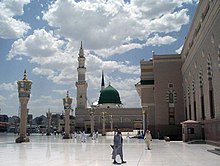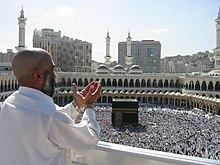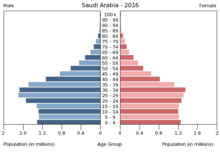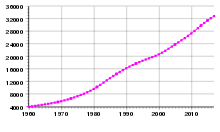Saudi Arabia
Template:Infobox State/Maintenance/TRANSCRIPTION
Template:Infobox State/Maintenance/NAME-German
Saudi Arabia (obsolete also Saud Arabia or Saudi Arabia, Arabic المملكة العربية السعودية al-Mamlaka al-ʿarabīya as-saʿūdīya, Kingdom of Saudi Arabia) is an absolute monarchy in the Near East. It is located on the Arabian Peninsula and borders its littoral states (see country border below), the Red Sea, and the Persian Gulf. A resident of Saudi Arabia is called a Saudi or a Saudi Arabian.
Two of the three holiest sites of Islam, the Kaaba in Mecca and the Prophet's Mosque in Medina, are located in Saudi Arabia. The country has existed in its current borders since 1932, and absolutism as a form of government was enshrined in the 1992 Basic Law. The capital and largest city of the country is Riyadh, the second largest is the port city of Jeddah.
Islam of the Hanbalite school of law in the special form of Wahhabism is the state religion in Saudi Arabia, the public image of religion in the country is fundamentalist religious Islamic conservative, and a conservative interpretation of Islamic law, the Sharia, prevails. Saudi Arabia supports and finances the spread of Islamist neo-fundamentalism. Thus the views of the terrorist organization Islamic State were strongly influenced by the Saudi Arabian interpretation of Islam, of which they are a particularly violent extension. On the human rights situation, see Human Rights in Saudi Arabia; according to the Global Gender Gap Report, the country ranks last in the world in terms of women's rights. Freedom of expression is non-existent, and punishments such as amputation, stoning, flogging and the death penalty are regularly carried out, the latter also for homosexuality. Under the de facto ruling Crown Prince Mohammed bin Salman, however, a cautious "modernization" of society is being initiated.
Saudi Arabia's oil exports make it one of the richest countries in the world; it ranked 14th in the world by gross domestic product per capita (adjusted for purchasing power) in 2016, and 36th in the Human Development Index in 2019. Thanks to its wealth, the country can afford to provide its population with generous social benefits, and it thus ensures political stability at home. Increasing pressure on the national budget due to the drop in oil prices since the beginning of 2015 has forced the country to diversify its sources of revenue. The "Vision 2030" reform project aims to make this a reality.
Geography
The Arabian Peninsula consists largely of an extensive highland. In the west, the plateau forms a steep break in the edge, which runs parallel to the coast of the Red Sea. In the northwest there is practically no coastal plain. The highest peaks are in the southwest in the Asir Mountains. The highest mountain is the Jabal Sauda with 3133 meters.
East of the rim break, the inhospitable highlands gradually slope down to the shallow waters of the Persian Gulf, whose coast is lined with marshes and salt flats. The highlands consist mainly of a vast sandy desert and stretches of bare volcanic rock. A broad band of desert, "the Empty Quarter" Rub al-Chali, stretches across the entire south of the country.
Country border
Saudi Arabia is bordered by Jordan (744 km common border), Iraq (814 km), Kuwait (222 km), Qatar (60 km), the United Arab Emirates (457 km), Oman (676 km) and Yemen (1458 km). Saudi Arabia and the island of Bahrain are connected by a highway, the 26 km King Fahd Causeway via bridges, causeways and an artificial island. On this island is the state border with Bahrain. What is striking about the course of the border is that it is very straight, especially in the north, without large bulges.
Saudi Arabia borders neighboring countries to the north, northeast, and south, and is bounded by the Red Sea and the Persian Gulf to the east and west. Saudi Arabia has a total of 4431 kilometers of land border, the longest section is the border with Yemen.
The border with Yemen was secured by barriers in 2003 and 2004, which led to diplomatic disagreements between the two states. Border disputes have also arisen with other neighboring states, such as the United Arab Emirates (1974) and Kuwait (1975). Between 1981 and 1983, the Neutral Zone was divided between Saudi Arabia and Iraq; in 1971, the second Neutral Zone north of al-Hasa had already been divided between Saudi Arabia and Kuwait.
EADS, now Airbus Group, is involved in the construction of the border facilities and border security. Police officers from Germany were sent to the country to train the personnel.
Climate and geology
Saudi Arabia has a predominantly hot and dry climate. The continental climate in the interior shows partly considerable temperature differences, especially between day and night. In summer, maximum temperatures of 50 °C are possible during the day, while in winter, temperatures can drop below freezing at night. The average annual temperature is 28 °C. Most of the sparse annual precipitation falls between December and February.
The supply of drinking water has always been ensured due to the country's wealth, although water scarcity is a growing problem because groundwater reserves are slowly depleting. Saudi Arabia has neither rivers nor lakes and is countering the water shortage by building deep wells and seawater desalination plants, which consume a significant amount of energy. The coasts of the Persian Gulf and the Red Sea are partially polluted with oil.
Geologically, Saudi Arabia lies on the Arabian Plate, which tilts to the east. In the west, it rises steeply from the Tihama Plain on the Red Sea with the exposed Precambrian rocks of the Arabian Shield, partly covered by younger volcanic rocks. While the northern landscapes, such as that of Hejaz, form more of a chain of mountains and hills along the coast, the more southerly Asir, similar to Yemen, is characterized by the rim escarpment, which is more than 1000 meters high over long stretches. From this coast-parallel edge, the land slopes gently eastward. From west to east, the monotonous landscape is initially formed by extensive scree deserts, covered in the west by many lava fields (harrat) or basalt boulders. Further east, younger strata have preserved, each beginning with a scarp to overlie the older strata. The largest of these escarpments, both in height and extent, is the escarpment of the Tuwaiq Escarpment, whose strata are of Jurassic age and are immediately preceded on the west side by a sand strip. In the central area these sand strips bear names such as (from north to south) Nafud as-Sirr, Nafud Qunaifidha and Nafud ad-Dahi. On the plain east of the Tuwaiq are the localities around the wells of Khardzh and the capital Riyadh, while further north are the localities of Qasim west of the northern Tuwaiq foothills, which eventually submerge beneath the sands of the Great Nafud. This plain, which forms a large part of the Najd landscape, is in turn accompanied for long stretches on the east by a precipice, the Buwaib, the strata of which belong to the Cretaceous period. On its plain runs the Dahna sand strip, which bounds the whole of the central landscape to the east. This is over 100 kilometres wide in places and feeds the Rub al-Chali in the south with sand from the Great Nafud Desert (an-Nafud al-Kabir) in the north. Further to the east follow more partly stepped plains, over which scree deserts extend on essentially limestone bedrock. Then to the east, dried-up former lake basins and salt flats increase until the coast is reached, which, measured in geological time, slowly rises from the Persian Gulf. Together with the gradual decline in precipitation since a brief wet phase a few thousand years ago - around the beginning of the Neolithic (Neolithic subpluvial) period - this conditions a gradual siltation and desiccation along the Arabian coast of the Persian Gulf. In the north and south of the country, the two great deserts of the Great Nafud and the Rub al-Chali dominate the landscape. Both reach the highlands of the Western Rim Mountains in the west. The central Tuwaiq Escarpment embraces the Arabian Shield like a vast arc open to the west, from which it is generally separated by the narrow sand fields.
flora and fauna
In most parts of the country, vegetation is limited to low grasses and small shrubs. Date palms grow in scattered oases. The Arabian oryx antelope was characteristic of the deserts of the Arabian Peninsula. However, the animals were wiped out by hunting in the recent past. Today, due to reintroduction programs, they live again in small numbers in their original habitats. One population lives in the western part of Saudi Arabia, in a huge fenced game reserve, the Mahazat-as-Sayd Sanctuary. Saudi Arabia's native fauna also includes various gazelles, Arabian wolves and Nubian ibex. Mantled baboons live in Asir National Park in the mountains in the southwest of the country. Some of Arabia's large animals, such as the cheetah and ostrich, are now extinct, while others, such as the leopard, have become very rare. Some bird species are also threatened with extinction.
Wild cats, desert-dwelling flying fowl, burrowing rodents and desert rats, as well as various reptiles and insects are widespread. The forest bustards, rediscovered in Syria a few years ago, also migrate to Saudi Arabia. The collared parakeet is found as a neozoon in many settlements. In the coastal waters of the Red Sea there are many marine animals, especially in the coral reefs.
Places of interest
Mada'in Salih, near the provincial town of al-Ula halfway between Medina and Ha'il in the north of the country, is by far the most famous ancient site in the country. It is a rock-cut burial site that is about 2000 years old. Remarkable about it are the rock inscriptions in Aramaic and Thamūdic, well preserved due to the dry weather. Very unusual in this area are the particularly numerous - due to weathering - rock formations, which appear to the viewer like images of animal and human figures. Other places of interest are the skyscrapers Kingdom Centre and Al Faisaliyah Center in Riyadh, the old city of Jeddah, the holy sites of Islam or the ruined quarter of Diriyya, which bears witness to the Ottoman-Saudi War. Jabal al-Qara is a sandstone formation in al-Hasa province. It is located west of the town of Hofuf and is a picturesque formation about two kilometers long and 1.2 kilometers wide.

Local family at a picnic in the desert at the foot of the Jebel Tuwaiq, the men at prayer
Population
Saudi Arabia has a population of over 33 million. Of these, over 11 million are foreigners living legally in the country. The population has grown tremendously since 1950 when it was 3.5 million. The population of Saudi Arabia lives mainly in the cities and a few oases. The original inhabitants were almost exclusively Arabs. Today, 90% of the population is of Arab descent, either native Saudis or people from the Arab world, mainly Egyptians, Jordanians, Palestinians, Syrians and Lebanese. The remaining 10% are mostly of African or Asian descent. Non-Arab foreigners are mostly guest workers. For migrant workers in Saudi Arabia, the kafala system comes into play. The country is inhabited by about 400 tribes, and over one-tenth of the inhabitants are nomads or semi-nomads. The state social insurance GOSI is only available to nationals free of charge - yet millions of foreigners and guest workers live in the country.
Saudi Arabia has a population density of twelve inhabitants per km². 86% of the people live in the country's cities. The average life expectancy is 75.7 years, and it is higher for women (77.8 years) than for men (73.7 years).
The average age in 2016 is 26.2 years for women and 27.9 years for men. The overall average age is 27.2 years. In 2016, 50% of the 21 million natives were younger than 30 years. There are 13 cases of infant mortality per 1000 births and a maternal mortality rate of 12 per 100,000 births. This means that the Saudi Arabian population is growing by 1.5% per year. Due to the low average age combined with a relatively high life expectancy, the country has one of the lowest death rates in the world (3.3 per 1000 population). Since most of the guest workers in the country are male, the country has a high surplus of men. In 2016, there were 116 men for every 100 women. HIV infection is very low due to extremely strict sex laws, moral guardians and prudery. A growing health problem is widespread obesity. In 2016, 69.7% of the adult population was overweight and 35.4% were obese. Both are among the highest rates in the world.
The overall literacy rate of the Saudi Arabian population is 94.7%, which is above the world average. In this context, 91.1 % of Saudi Arabian women are able to read and write, while men have a literacy rate of 97.0 %. (As of 2015). In Saudi Arabia, there are on average 2.1 doctors per 1000 inhabitants and 3.3 beds in a state hospital.
High Arabic is the official language, English is considered the language of commerce; there are also some Arabic dialects that are restricted to oral use, such as Yemeni Arabic in the southwest.
Guest workers
Saudi Arabia employs nearly 11 million migrant workers. They come mostly from Asia - India, Pakistan, Bangladesh, Sri Lanka, Maldives, Malaysia, Philippines, Indonesia, Brunei, Iran, Turkey, Central Asia - and Africa - Sudan, Ethiopia, Eritrea, Djibouti, Somalia, Kenya, Comoros, Chad, Mauritania and others. There are also a smaller number of highly skilled guest workers from Europe, North America and other regions. These guest workers from Western countries mostly live in compounds. These are hermetically sealed and guarded settlements. These compounds have an autonomous infrastructure with shops, swimming pools, sports facilities and the like. A "Western" way of life in these compounds is tolerated. In May 2004, 19 foreigners were killed in a terrorist attack on a compound. U.S. soldiers from the United States Military Training Mission (USMTM) in Saudi Arabia, which trains the country's armed forces, also live in such compounds. The headquarters of the USMTM is in Taif; there are also various field offices.
The guest workers mainly work in sectors in which Saudis do not want to work or do not have the necessary qualifications. About 67% of the five million working Saudis work in the public sector. A quota system ("Saudisation") is to help increase the share of locals in the private sector in 2016; for example, a quota of five to seven percent is targeted for the construction industry, and 10-25 % for the retail sector.
| Most common countries of origin of migrants in Saudi Arabia by country of birth (as of 2015) | ||
| Rank | Country | Number of migrants |
| 01 | India | 1.894.000 |
| 02 | Indonesia | 1.294.000 |
| 03 | Pakistan | 1.123.000 |
| 04 | Bangladesh | 0.967.000 |
| 05 | Egypt | 0.728.000 |
| 06 | Syria | 0.623.000 |
| 07 | Yemen | 0.528.000 |
| 08 | Philippines | 0.488.000 |
| 09 | Sri Lanka | 0.400.000 |
| 10 | Nepal | 0.381.000 |
Religion
The main and state religion is Hanbalite Islam in its Wahhabi character, to which 73% of the population belong, especially in the Najd and the north.
Other Sunnis make up 12 % of the population, Shiites about 10 to 15 %. The Shiites live mainly in the east of the country, Ismaili Shiites in the southern province of Najran. Since Ibn Saud conquered the eastern province of al-Hasa in 1913, the Shiites have had to be careful not to "harass" the Sunnis by their manner of religious practice. Over the past few decades, especially since 2009, tensions between the Sunni majority and the Shia minority have intensified. Since the Saudi ruling house sees itself as the guardian of pure (Sunni) Islam, the government tolerates anti-Shiite propaganda. Numerous Saudi Sunni theologians condemn Shiite beliefs and practices in their writings; some-such as Nasir al-Umar (The Situation of Deniers in the Lands of Monotheism, 1993)-even go so far as to call Shiites "deniers" and deny them being Muslim.
In 2012, in a Gallup poll, 19% of Saudi respondents described themselves as "non-religious" and another 5% as "staunch atheists."
Islam's two holiest sites, the Kaaba in Mecca and the Prophet Muhammad's resting place in Medina, are located in Saudi Arabia, making the country the destination of several million pilgrims each year, especially during the Hajj. Theft during the Hajj can be punished by forced amputation of a hand or death. The holy Zamzam water spring, the Minā Valley, and Mount ʿArafāt, where the Prophet Muhammad delivered his last sermon, are also located in Saudi Arabia.
The influence of the clergy in the country is very great and has increased further in recent years. The lifestyle of a number of members of the Saudi royal family, which contradicts Islam, polarises society. Commentators therefore believe a religiously motivated coup by fundamentalist clerics is conceivable one day.
Clerics in Saudi Arabia bear the title "Sheikh" or "Alim". The mufti or grand mufti is the supreme spiritual scholar of Saudi Arabia. The current mufti, Sheikh ʿAbd al-ʿAzīz Āl ash-Shaykh, preached against terrorism on pilgrimage in 2005, calling its acts an "attack on and discredit to Islam." Well-known scholars of Saudi Arabia were Abd al-Aziz ibn Baz and Muhammad ibn al-Uthaymin.
See also: History of the Jews in Saudi Arabia, Christianity in Saudi Arabia, and Roman Catholic Church in Saudi Arabia.

The Prophet's Mosque (al-Masjid an-nabawi) in Medina

streams of pilgrims in Mecca

Population density in Saudi Arabia (person per km²), the most densely populated province is Dschāzān

Saudi Arabia has a young population and a high surplus of men due to the guest workers in the country

Population growth in Saudi Arabia, about 4 million inhabitants in 1961 to almost 32 million in 2015; FAO data, 2005.
Questions and Answers
Q: What is the official name of Saudi Arabia?
A: The official name of Saudi Arabia is the Kingdom of Saudi Arabia.
Q: How large is Saudi Arabia in terms of land area?
A: Saudi Arabia has a land area of approximately 2,150,000 km2 (830,000 sq mi).
Q: What countries border Saudi Arabia?
A: Saudi Arabia is bordered by Jordan and Iraq to the north, Kuwait to the northeast, Qatar, Bahrain, and the United Arab Emirates to the east, Oman to the southeast, and Yemen to the south. It is separated from Israel and Egypt by the Gulf of Aqaba.
Q: What language do people speak in Saudi Arabia?
A: Arabic is exclusively spoken in Saudi Arabia.
Q: What religion dominates in Saudi Arabia?
A: Sunni Islam is dominant inSaudiArabia. The ultra-conservative Wahhabism religious movement within Sunni Islam has been called "the predominant feature of Saudi culture".
Q: Are non-Islamic religions allowed in public or private places?
A: Non-Islamic religions are forbidden in public but not prohibited in private places.
Q: What currency doesSaudiArabiause?
A:The currency usedinSaudiArabiais referredtoastheSaudiRiyal.
Search within the encyclopedia